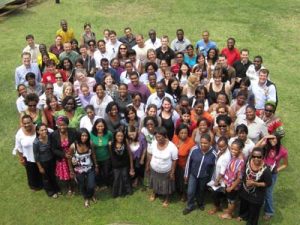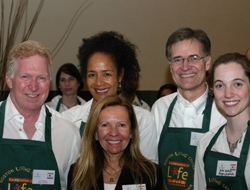
Communication and collaboration is the lifeblood of real scientific progress. Researchers often work long hours focused on their own research but getting together periodically with others in their field to share results gives a fresh perspective which often moves research forward.
This past October, Ragon Institute faculty, researchers and Steering Committee members attended a retreat sponsored by the HIV Pathogenesis Programme (HPP) at the beautiful Mondazur Resort, on the south coast of KwaZulu Natal, South Africa. For many it was their first visit to South Africa.
Attendees came from universities and research organizations such as Oxford University, Monash University in Melbourne, University of Nairobi, as well as several other South African universities.
The goal of the retreat was to enhance the research productivity and build capacity at the Doris Duke Medical Research Institute (DDMRI), home of HPP, by:
[list type=”6″]
[/list]
The 3-day retreat was successful in pushing forward these goals. As Ragon Steering Committee member Dr. Dennis Burton observed, “the retreat was very interesting and enjoyable, some excellent science, great to hear so many talks from young researchers.”

Students Discuss research during the poster session.
HPP and the Ragon Institute have a long history of collaboration. Beginning in 1999, Drs. Philip Goulder and Bruce Walker, founders of the Partners AIDS Research Center (PARC now the Ragon Institute), championed the establishment of a research facility in the heart of the South African AIDS epidemic. HPP was established and in 2003, with additional funding from the Doris Duke Foundation, the fledgling research laboratory moved to its new lab space at the Nelson R Mandela School of Medicine, University of KwaZulu-Natal.
Many Ragon Institute members were able to meet with traditional healers during their visit to South Africa. It is estimated that 85% of South Africans see a traditional healer as their first provider of health care when they fall ill. The iTeach program is at the forefront of the effort to involve traditional healers in the management and treatment of HIV/AIDS.
On the last day of the retreat, nurses from the various research sites spoke to the group about their day-to-day experiences. Additionally, a patient from the Sinikithemba cohort spoke about how the program changed her life. Although HIV is so prevalent in South Africa, publicly disclosing one’s HIV infection status is still likely to lead to ostracization by family and friends. For most people, the clinic is the only place where they feel it is safe to disclose their HIV status. Over 12,000 patients have been diagnosed and enrolled in the HIV care program since its establishment.
After three days of scientific collaboration, all went away energized for new collaborations and discovery. Said Dr. Burton in conclusion, “I thought the retreat reflected very well indeed on the high quality of science at HPP. I look forward to the next retreat, which I hope will be soon!”
Since then, HPP has grown considerably in size to 82 personnel including 5 local researchers with independent grant funding. There are now four clinical sites where studies are undertaken and patients recruited. Professor Thumbi Ndung’u is the Scientific Director of the unit. He and his team at have published extensively in the fields of HIV molecular virology and immunology.

The group at the HPP Retreat, October 2010.
In addition to the formal talks and the team building exercises, the relaxed atmosphere created an opportunity for many HPP students to meet informally with Ragon Institute Steering Committee members. Students and young investigators were able to receive answers to their questions and career advice from seasoned scientists like Dennis Burton, Laurie Glimcher, and Arup Chakraborty.
Said Dr. Burton: “I very much appreciated the chance to talk outside the conference room with a selection of individuals. I loved [the students’] enthusiasm.”
Steering Committee members also had opportunity to go on home visits with Dr. Krista Dong and other local health care providers to meet patients who were part of the iTeach Warrior Program.
The Warrior Program identifies patients who may have AIDS or TB and have not yet been tested. The sickest patients are then “fast-tracked”, speeding their diagnosis and treatment initiation. In addition to ensuring life-saving treatment is started, the Warriors provide one-on-one counseling, assist with disclosure to their family members and link patients to a clinic for ongoing care after hospital discharge.

The Irvine Lab lives at the intersection of immunology and engineering.
“My lab is devoted to figuring out how to deliver drugs and vaccines that better target the immune system,” says Dr. Darrell Irvine. “We’re trying to learn how to make the immune system mount more effective attacks against cancer, HIV, and other diseases.”
Toward that goal, the Irvine Lab combines state-of-the-art chemistry, polymer science, physics and immunology to address critical biological questions and medical challenges.
Dr. Darrell Irvine received his Bachelor’s degree in Engineering Physics from the University of Pittsburgh and his Ph.D. in Polymer Science from the Massachusetts Institute of Technology.
But Irvine found himself more and more interested in immunology. “The complexity of how the immune system operates, all of these cell-cell interactions that have to happen at the right place at the right time, this enormous level of regulation—it was all just fascinating,” he says.
Later, as a Damon Runyon-Walter Winchell Postdoctoral Fellow, Dr. Irvine moved from the physical sciences to the life sciences, studying fundamental aspects of T-cell recognition in the laboratory of Mark M. Davis at Stanford University.
On his return to MIT in 2002, with a dual appointment in Materials Science & Engineering and Biological Engineering, he established a laboratory focused on the development of new materials for immunotherapy, drug delivery, and basic immunological studies.
The Lab research focuses on developing synthetic nanoparticles and microparticles that can be used to deliver vaccine antigens and immunostimulatory adjuvant molecules. These delicately engineered materials release chemicals inside the body to “program” immune cells to combat viral infections like HIV. A mechanistic understanding of the immune system provides a guide to the design of these materials but it also requires a deep understanding of the immune processes. Therefore, the Irvine Lab is made up of both engineers and immunologists. “My philosophy is that we can’t make a technology that’s really going to help against these diseases if we don’t fully understand the biology that underpins the response,” he says.
Additionally, the Irvine Lab is using new imaging technology to shed light on how individual lymphocytes can kill an HIV target.
Irvine has been particularly interested in the unique immunologic response of HIV Controllers. Sophisticated imaging measures how fast T cells, the first line of defense in the body’s immunologic response, move from one virus target to another and has demonstrated that the T cells of HIV Controllers are extremely efficient as compared to those of chronically infected patients. With almost 100 percent effectiveness, T cells of HIV Controllers kill their first encountered target very quickly– this may be one feature that distinguishes HIV controllers from others who quickly succumb to the infection is this effective first attack. In terms of vaccine design, the research suggests that you would want a large number of these cells to quickly come in and rapidly attack and kill that first wave of infected cells at the site of infection.
Still, questions remain: After the first kill, why do T cells stop and for how long? How long does it take T cells to kill one target and then move on to another? How is it that they track down and kill these very fast-moving target cells that are able to move as rapidly as they can?
Says Irvine, “This is an exciting time to be doing this work because underlying molecular mechanisms are starting to be understood, and chains of cause and consequence are now being established.”
“To meet our goals, engineering must be married to an in-depth appreciation for the biology behind these processes,” says Dr. Irvine.
The Irvine Lab aptly demonstrates the exciting results of connecting marrying engineering and immunology.

For a second year, the Ragon Institute has volunteered at the Boston Living Center’s Celebration of Hope. This year the Ragon Institute team, under the leadership of Dr. Hendrik Streeck, was the largest server team at the event and raised over $4,100 which will go toward the community outreach programs of the Boston Living Center.
The Boston Living Center (BLC) is a non-profit community and resource center whose mission is to foster the wellness of all HIV positive people and respond to the changing needs of the HIV/AIDS community.
The Annual Celebration of Life dinner is the BLC’s largest yearly event and accounts for the majority of its annual funding. The event provides a full Thanksgiving dinner and entertainment for anyone living with HIV/AIDS, their family and loved ones.

l-r: Volunteer servers Terry Ragon, Marylyn Addo, Susan Ragon, Bruce Walker, and Kate Walker.
This year’s Celebration of Life dinner took place on Tuesday, November 23, 2010, at the Hynes Convention Center and was a huge success.
Dr. Streeck, who recruited and organized the Ragon volunteers, called the response “overwhelming.” Over 45 persons from both the Ragon Institute and Intersystems volunteered at the dinner in set up and break down for the event, as well as serving the dinner and staffing the coat check. Volunteers served Thanksgiving dinner to 650 persons with HIV/AIDS and their loved ones and were invited to join as dinner guests as well.
BLC Director of Development and Communications, Marc Davino, gave a special thanks to the Ragon Institute for its generous support. “The Ragon Institute has been very kind to the BLC the last two Thanksgiving events,” he said.